For once in our life, we all came across strange or unusual plants. In general, familiarity with such representatives of the plant world begins in childhood, when we see a cactus, and do not understand what it is. We are told that it is a plant. But after all, neither the leaves nor the stem, nothing that the child considers to belong to a normal plant, no. Here are some of the unusual plants that are more like people from other planets.
Welvichia is amazing (Welwitschia mirabilis).
This desert dwarf tree can live to 2000 years. The trunk of the plant is short and hemp-shaped, a pair of leaves are moving out of it in two directions. As they grow, they break into longitudinal ribbons, and their tips wither. The age of these giant leaves is equal to the age of the tree itself. Despite the extinction of the tips, the leaves from the base constantly grow at a speed of 8-15 cm per year. Sometimes the length of the leaves can reach 8 meters, and their width - 1.8 meters. Velvichiya grows in the south of Angola, in the rocky desert. Typically, the plant can be found no more than a hundred kilometers from the coast - it is vital he needs fogs that give moisture. The plant itself is extremely austere, the leaves twisted with a turban help the precious water to get to the roots.
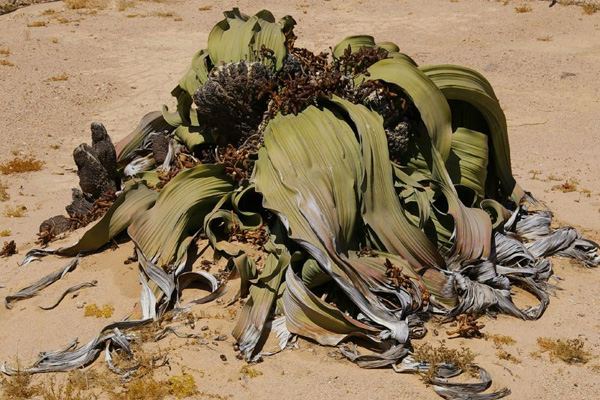
Rafflesia.
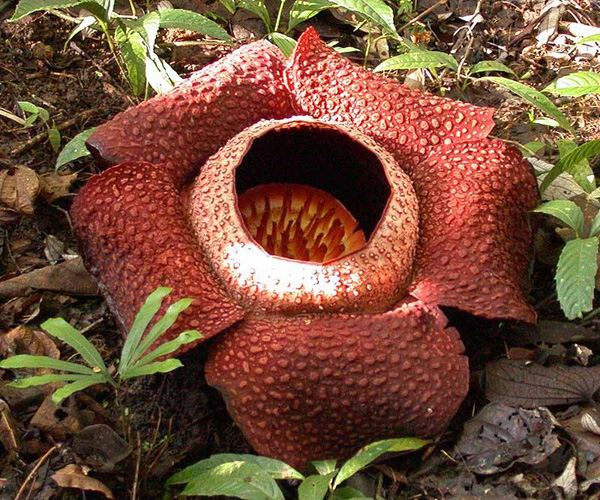
Amorphophallus.
This genus, like rafflesia, is famous for its fragrance of decaying flesh. The flower has a terrible smell, few people can stand next to it without special protective equipment. Most members of the genus have a huge flower, so in some plants of the species Amorphophallus titanum it can reach a height of 2.5 meters with diameters of 1.5 meters. This, by the way, is one of the world's largest inflorescences. Amorphophallus grows in the tropics and subtropics, on the plains. Interestingly, in many countries of the East, plant tubers are widely used in cooking. Thus, in China, Amorphophallus has been cultivated for 1500 years as a dietary product that lowers cholesterol. In Japanese cuisine, tubers are used in cooking soups, they are added to stews.
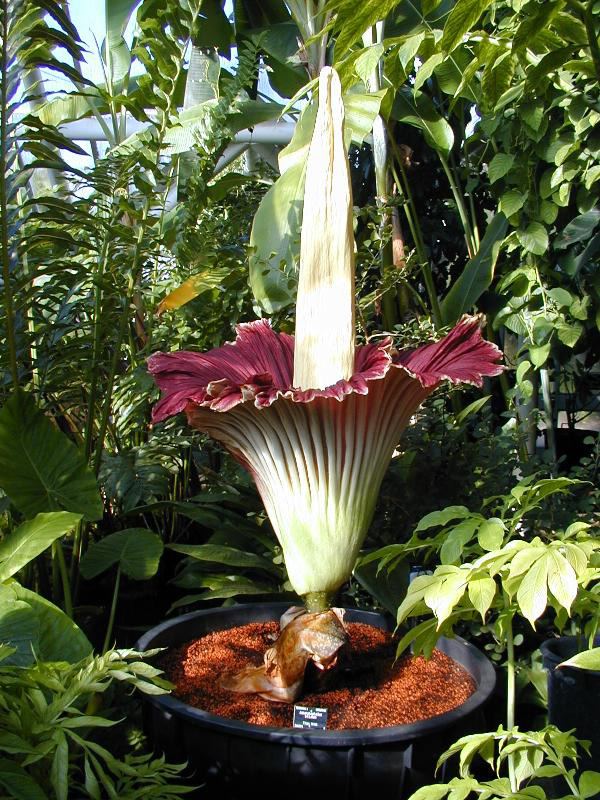
Opuntia Bigelovii (Opuntia bigelovii).
This is one of the most amazing species of the Opuntia cactus family. Usually in the area where this species grows, you can see a large number of fluffy two-meter cacti. When the sun goes down - it looks fantastic. A person who finds here may get the impression that he has visited another planet as part of a space expedition, around which there are unknown life forms. Prickly pear is valuable for its fruits, it is also used as a hedge and as animal feed.
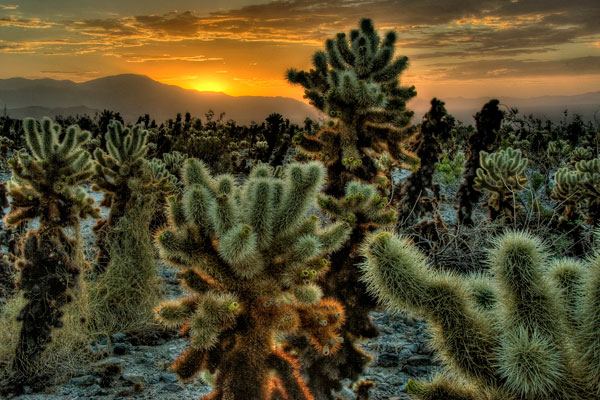
Carnegia the giant (Carnegiea gigantea).
This is another one of the amazing plants of the Cactus family. The most amazing thing about him is his size. Carnegia growing in Arizona, Mexico and California can reach as high as 14 meters, and its diameter is up to 3 meters. Separate cacti live up to one and a half centuries.
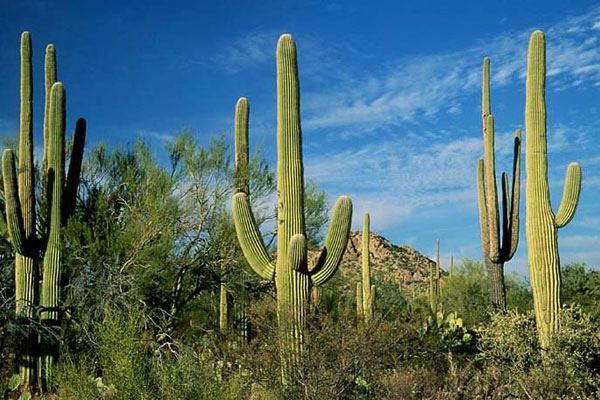
Nepentes (Nepenthes).
Virtually all plants of this genus can be safely called predators, since they obtain the necessary nutrients by digesting the caught insects. Most species grow in the tropics of Asia, mainly on the island of Kalimantan. The plant leaves resemble the shape of a water lily. To attract insects, there are special cells on the inner surface of the pitcher that secrete attracting nectar, hair cells are also present, which serve to hold the caught victim. The trap is very sophisticated - the surface on the neck of the jug is very slippery, so the victims and slide down where they fall into the water and drown. Some species contain in a water lily up to 2 liters of water. Enzymes are produced by the plant to process insects, sometimes even mice, rats and small birds fall into the trap.
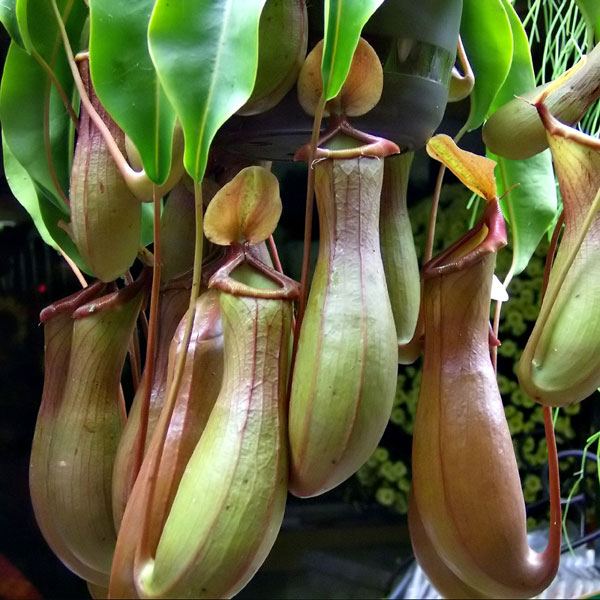
Venus flytrap (Dionaea muscipula).
This plant killer is even more amazing, as it is taking much more active actions to seize prey. The leaves of the plant are peculiar jaws that slam, capturing not only insects, but even snails and frogs. Digestion takes about 10 days, on average during the life of the plant 3 insects fall into its jaw. The flycatcher grows in the temperate zone, on the Atlantic coast of the United States.
.
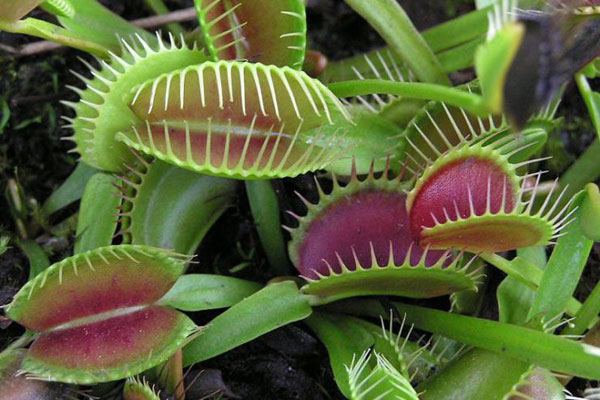
Ficus bengale (Ficus benghalensis).
Many people in the photos see not one plant, but their whole forest, although this is erroneous. The fact is that this ficus is characterized by a special form of life - banyan. The ficus forms powerful branches, from which shoots or “airy” roots grow down. Most of them dry up, never reaching the ground, more successful ones take root, forming new columns-trunks. This plant grows in India, Sri Lanka and Bangladesh. The tree can eventually grow so that it takes a few hectares.
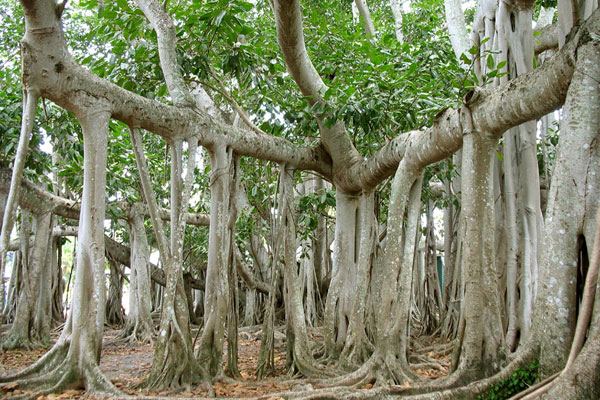
Evergreen Sequoia (Sequoia sempervirens).
This tree, growing in California, is known for being the tallest tree in the world. In comparison, our temperate forests are just grass. This is not surprising, because some reach the age of 3500 years, and the height exceeds 110 meters. The diameter of the largest sequoia was more than 11 meters. Some of the most remarkable trees even have their own names; sometime in the trunks of such trees, houses were hollowed out and tunnels for roads were cut through. When a strong wind blows, being in a forest with redwoods can become unpleasant - not everyone can withstand the swaying of the gigantic trunks and the noisy grinding of them.

Puyya Raymonda (Puya raimondii).
This plant grows in the Peruvian and Bolivian Alps. It is known for having the largest inflorescence, which is 12 meters high and up to 2.5 meters in diameter. It consists of 10 thousand simple flowers. Puya blooms only once in a lifetime, reaching its 150th anniversary, after which the plant dies.
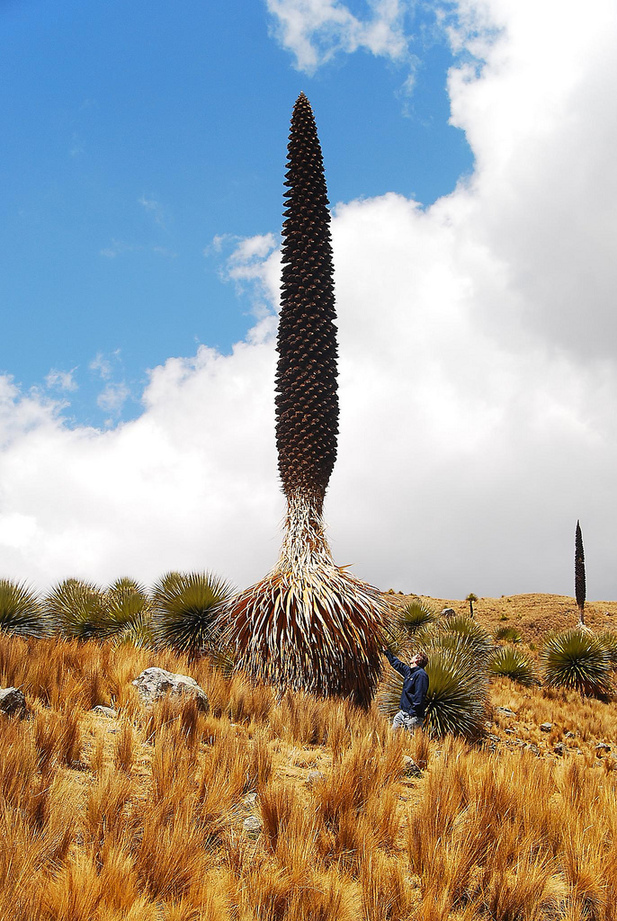
Ongaunga (Urtica ferox) or New Zealand nettle tree.
This plant has a tree trunk, and its thorns are unusually dangerous. They contain formic acid and histamine. The nettle tree can reach 5 meters in height, the slightest touch to it leads to the appearance of a painful burn. There have been cases of death from the poison of a tree of horses, dogs and at least one person. Interestingly, the plant is the main food of the Red Admiral butterfly larvae.
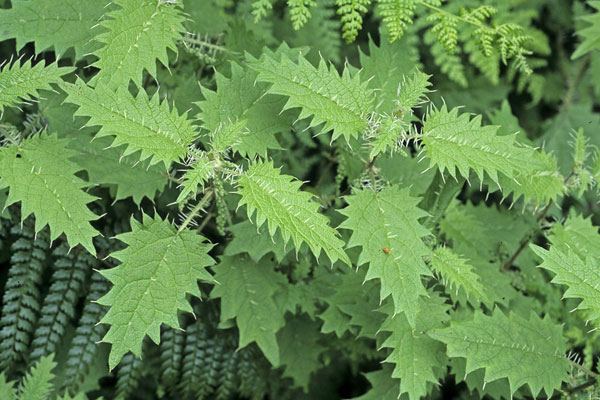
Ginkgo (Gínkgo bilóba) - relict plant that grows in China. The species originated 16 million years ago, so this plant is the oldest of those growing on the planet. Another name for ginkgo is silver apricot. The shape of this tree with falling leaves, plant height can reach 30 meters. Some trees can live up to 2500 years. Medicinal preparations are prepared from ginkgo leaves. Recently it has become fashionable to use compounds from leaves, although the medical effect from them is far from obvious.
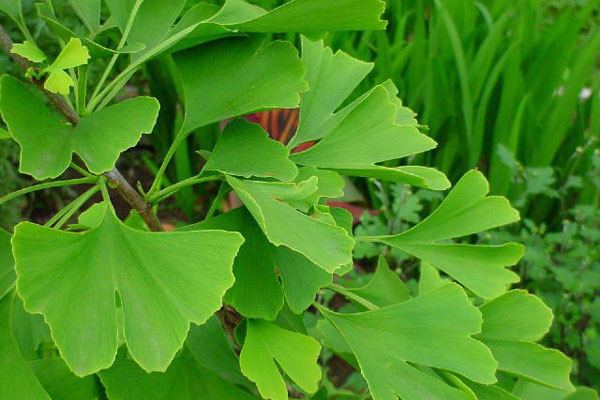
Cedar Apple Rotting Mushroom (CEDAR-APPLE RUST FUNGUS). Cedar-apple rotting mushroom is a fungal infection that transforms apple and cedar fruits beyond recognition. About this abomination, you can shoot horror movies: infected fruits literally in a few months turn into disgusting monsters. Here's how it happens: a spherical body develops from a tiny spore of a fungus — from 3.5 to 5 centimeters in diameter; when it gets wet, this abomination is stratified, forming disgusting tendrils.
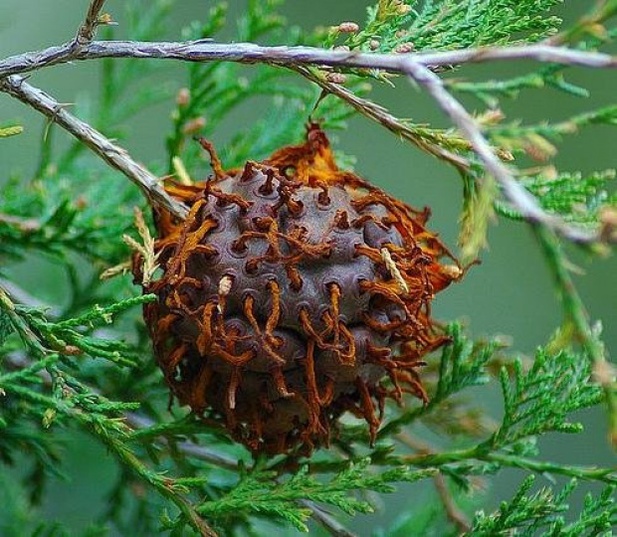
Bloody tooth (HYDNELLUM PECKII). This cute fungus looks like a chewed chewing gum, dripping with blood and smelling like strawberries. But do not try to eat it, because it will be the last "delicacy" that you will taste in your life.
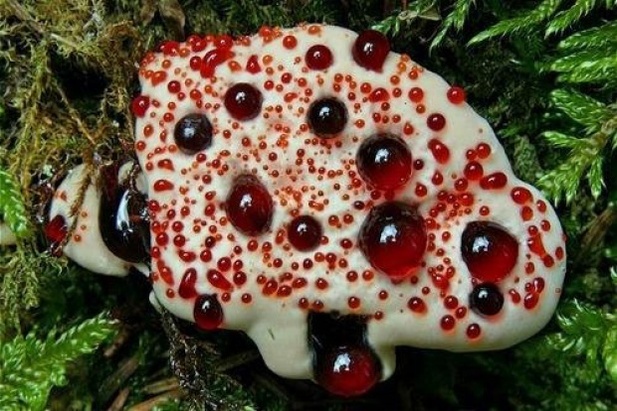
The smallest flower in the world has petals that do not exceed 2.1 mm in diameter and are so transparent that you can see through them. This flower is orchid (belongs to the genus Platystele), found in the roots of an orchid of another species by the famous American botanist Lou Jost.
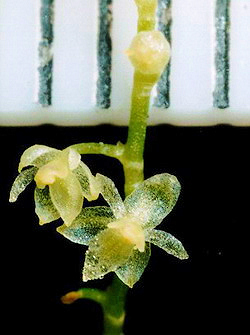
“School” welcomes its young readers and their parents. In an effort to continue to help you in your studies, we have prepared a new material for the project “Interesting Plants of the World”.
We are surrounded by a large number of unique flowers and trees, blades of grass and shrubs, which are striking in size and beauty, properties and abilities.
Having gathered facts about the unusual representatives of the flora, we tried to make the top five of the most attractive, from our point of view, “green inhabitants” of the planet.
Lesson plan:
Lover of flies
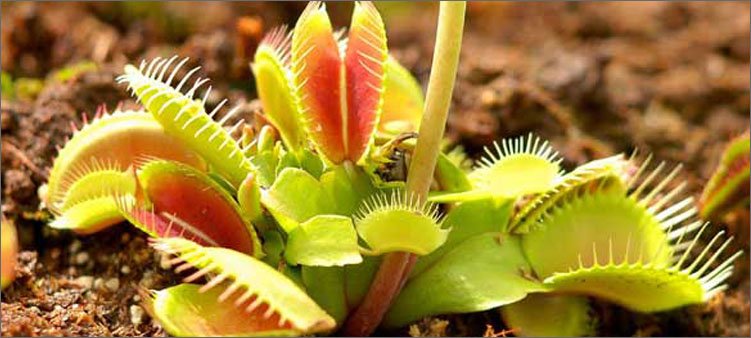
Opens our top ten plant - the hero of all kinds of cartoons called Venus flytrap. You cannot call it a flower, because it is a real predator, because the flycatcher feeds far from organic matter from the soil, as we used to read in a botany textbook about plants.
In the menu of Venus flytraps, there are various gaping and curious spider bugs.
The thing is that the plant has traps, which consist of leaves, all together forming a floral rosette. They smell tempting, attracting attention. Leaves-traps are only from three to seven centimeters in length, but so sensitive that as soon as the unlucky front sight or naive spider touches their surface, two leaves slam like a casket in less than a second!
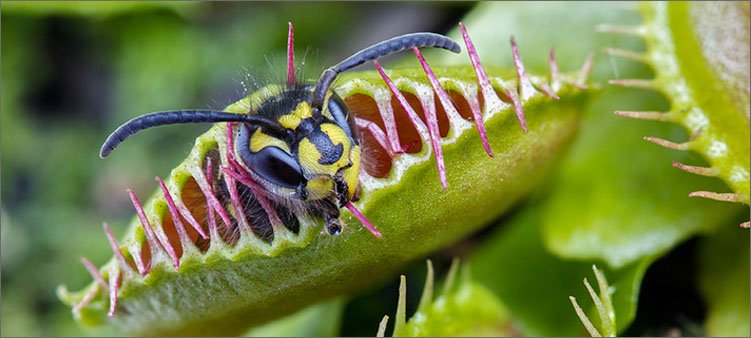
An insect caught in a flower is doomed to death. The edges of the trap grow together and for 10 days become an organ of digestion. And the more the “lunch” resists inside, the more actively the Venus flytrap begins to digest it. During its short life, each such leaf is able to eat about three insects.
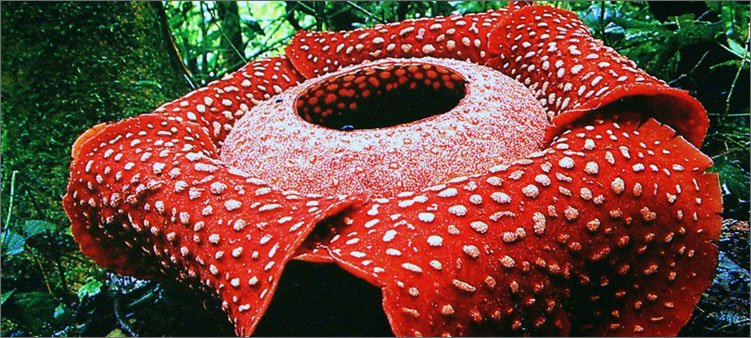
The most unusual plant in the world settles in the host with the help of a tiny seed. Scientists are amazed at how this seed manages to infiltrate hardwood to form a bud in a year and a half, from which a bud appears after nine months.

Rafflesia is attributed to the very best thanks to one of the largest single flowers on Earth.
In diameter it reaches one meter, and it can weigh as much as 10 kilograms!
At the same time, such beauty smells well, quite unpainted! Rafflesia, which consists of five fleshy petals in the form of bolshukhansky pancakes of red color with white warts, radiates the smell of rotting meat.
If it pushes us, people, then for dung flies it is akin to expensive perfumery. They gladly flock on a specific smell, pollinating the plant. It is a pity that to observe such beauty, having shut your nose, can be short-lived - rafflesia is dissolved only for three or four days.
Pans for birds
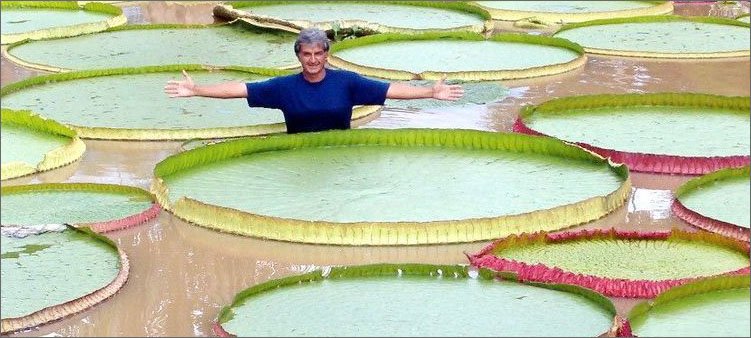
That is what the local residents of the coast - the countries of Brazil and Bolivia - call the world's largest water lily, which is scientifically called Victoria Amazon.
Green water lily saucers grow up to 2 - 2.5 meters in diameter and calmly hold a weight of up to 50, or even more kilograms.
In order not to sink under the weight of accumulated water, the clever water-lily punched its huge leaves with weirs — small openings through which excess water flows from the surface.
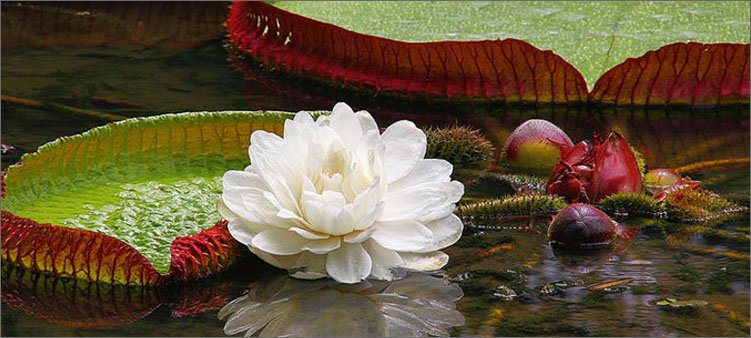
Have an unusual plant and unusual flowers. They are placed under water and only once a year come to the surface during flowering, which lasts only two or three days. At the same time, the modest people, about 30 centimeters in size, appear at night in their full beauty, and at dawn they hide from prying eyes again under water.
On the first night, you can see white flowers on the water, the next night, the Victoria's Victoria flower blooms pink, and on the last day it flaunts a raspberry or purple
Candy shop

What child does not dream of a mountain of sweets? Does it happen that sweets grow on trees? It turns out, it happens! Yes, and you can see the sweet tree not only in other countries, but even in Russia! You can easily find it in the Crimea and the Caucasus. It grows in China, Korea and Japan.
As early as the 17th century, the candy tree, the correct name for which is govenia, was grown in pharmaceutical gardens, as it was the source of many valuable substances for medicine and health. It was known that the candy tree in Tibet and India was rightfully considered a remedy for a thousand diseases. The Greeks and Romans magic caramel brought strength and vigor.
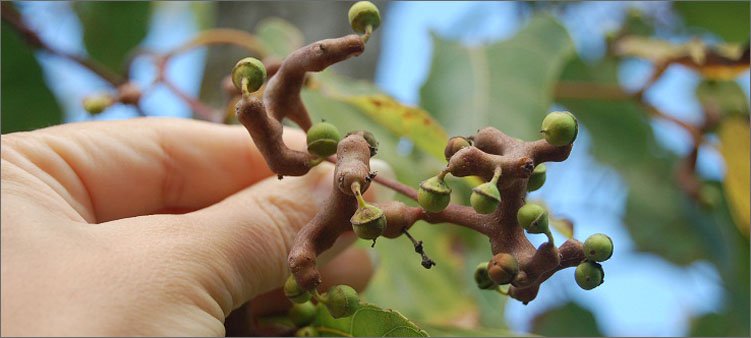
The fabulous plant is covered with oblong fruits, the taste of which is somewhat similar to the caramel barberry.
And there are those same caramels can be directly without departing from the tree itself from its branches. They make confitures and preserves, syrups and juices from sweet fruits.
In addition to the beneficial properties and delicious bright red caramels, govenia also has external beauty. When spring heat comes, it blooms with golden flowers, which emanate a magical scent. The tree is no less beautiful in autumn - it is covered with purple and yellow leaves.
Shy girl
Which of you did not see in the March holiday of March 8 a flower and bright yellow lumps, which we call mimosa. And we do not even think that he has nothing to do with the type of mimosa, because in fact it is a sprig of silver acacia.
But among the hundreds of species of real mimosa there is a bashful representative.
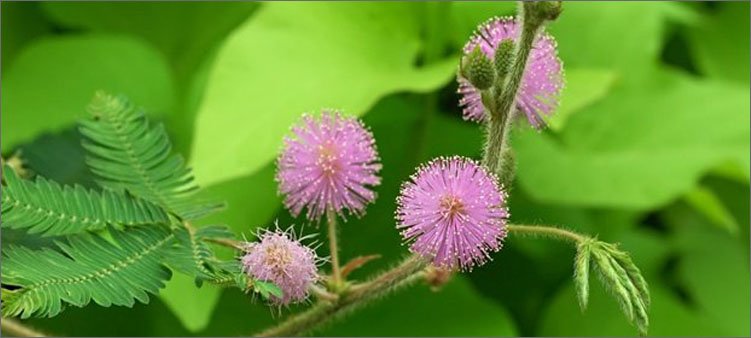
Why is she called that? Received a plant such a name is not by chance. It really shrinks from shame, just to touch its feathery petals. Mimosa bashful of awkwardness folds them, lowering the twigs.
If some time, about five to ten minutes, no irritants appear around the flower, mimosa, as if emboldened, dismisses its leaves. The plant cannot hide the petals from the hands of others for a long time, therefore with strong irritation from the energy depletion the flower may die.
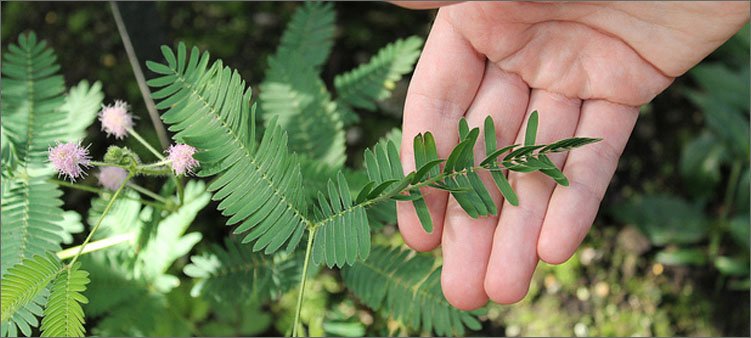
Touch-up mimosa can be seen in tropical Brazil, where it is perceived as a weed, as well as in Central America. There is it in other warm countries. Today, bashful mimosa can be grown as a houseplant, which throughout the summer will delight with pink or purple flowers, forming an inflorescence like a ball.
Here we have such an unusual five today!
Of course, in nature there are many other unique plants, for the description of which there is not enough space in this article. Perhaps we will come back to this topic and continue our list. After all, the planet still has:
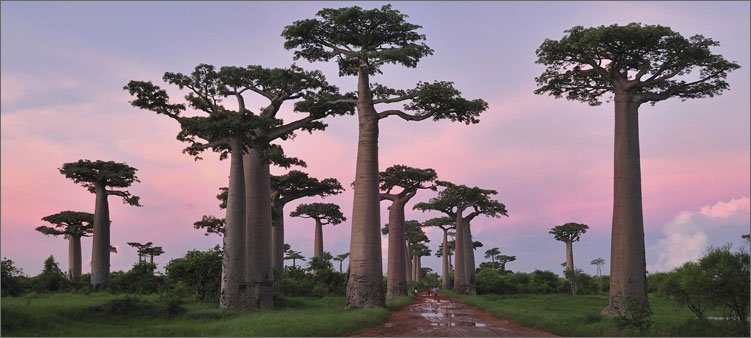
And also on the “School” blog you will find:
And many more other interesting TOPs)
Today, that's all!
To new interesting meetings!
Evgenia Klimkovich.
The world of plants is very attractive and diverse. On our planet, there are a total of approximately 360,000 plant species, which include flowers, grasses, trees, shrubs, surprising for their beauty, and sometimes for the original look. We invite you to get acquainted with the ten most amazing plants of the world, some of which are similar to people from other worlds.
If you see a cluster of raffles, you may get the impression that you have fallen on some other planet, where there are incredibly amazing plants and creatures. The unpleasant aroma of the flower attracts a huge number of flies, which pollinate the plant. Despite the nasty smell of the plant, the inhabitants of the islands (Sumatra, Java), where it grows, have long used it for the manufacture of medicines. For example, it is believed that the extract from flower buds improves male potency and allows women to restore their former forms after birth.
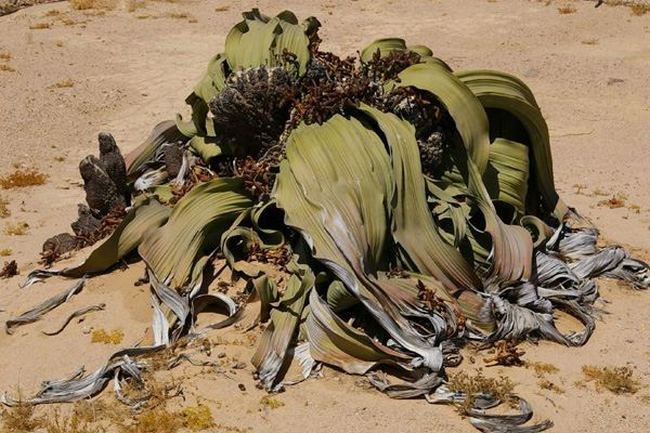
It is a dwarf tree that can live up to two thousand years. Refers to the most amazing plants of the world, because its leaves can independently spin to the center. This is vital for the plant, because in this way the leaves collect moisture from the mists and promote it to the roots.
The plant has a short stem (it looks like a stump), from which a pair of leaflets diverge in different directions. When they grow, they burst in the longitudinal direction into particles, and the tips of the leaves dry. In the year velvichii leaves, despite the drying of the tips, grow by about 8-15 centimeters. As a rule, the leaves in length grow to eight meters, and in width they can grow up to 1.8 meters. The dwarf plant is decorated with the stony deserts of Angola. Since Velvichia needs fogs, it grows no further than 100 kilometers from the ocean.
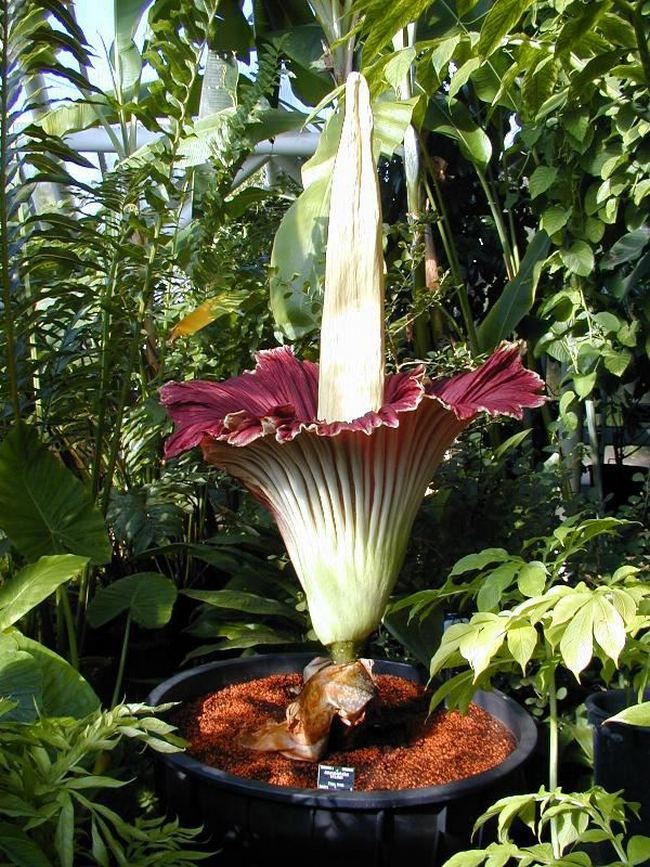
This plant also has a terrible smell of rotting meat, so admire them for a long time will not work. Most plants of this species have flowers of huge sizes. Their diameter can be one and a half meters, and in height they grow to 2.5 meters. The island of Sumatra, where you can see this flower, quite smelled the smell of these plants, which, by the way, are used by local residents as a medicine and for adding to various dishes.
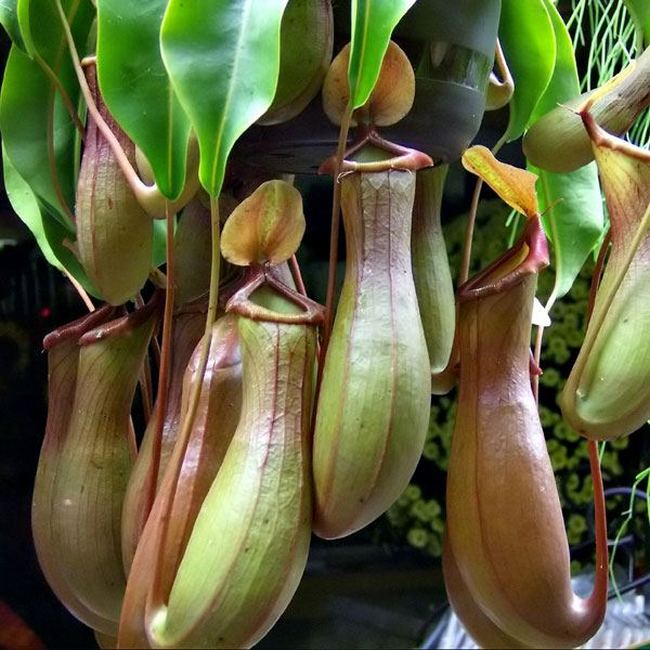
This is one of the most amazing plants in the world, which can be called a “predator”, as it lures insects into its “nets”. Digesting its "prey", Nepentes gets the necessary for the development of nutrients. Its leaves represent peculiar jugs, inside of which there are cells that secrete a special nectar that attracts insects, and hairs that do not allow insects that get inside the jug to get out. On the slippery surface of the leaves insects always roll into the water, the volume of which in a jug is sometimes as much as two liters. After the insects have drowned, the development of special enzymes begins, allowing them to "digest" food, which can even be mice, birds or rats.
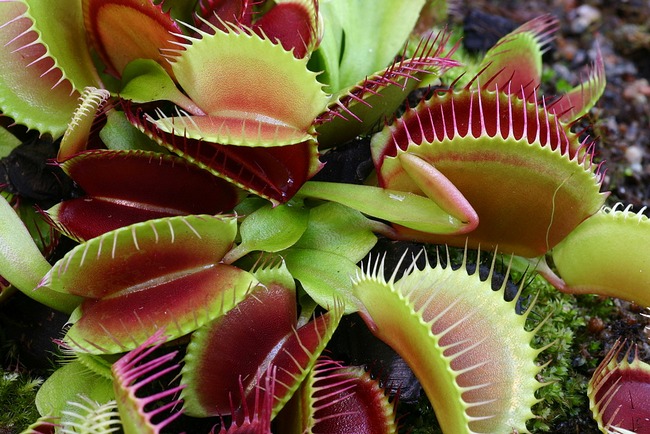
This plant, which can be found on the Atlantic coast of the United States, is also among the "predators." True, it acts more aggressively towards its “prey” - its leaves are a kind of jaws slamming immediately after insects (or even snails, frogs) have fallen into it. During the life of a Venus flytrap, an average of three insects are caught in it. The plant's "prey" is digested for about ten days.
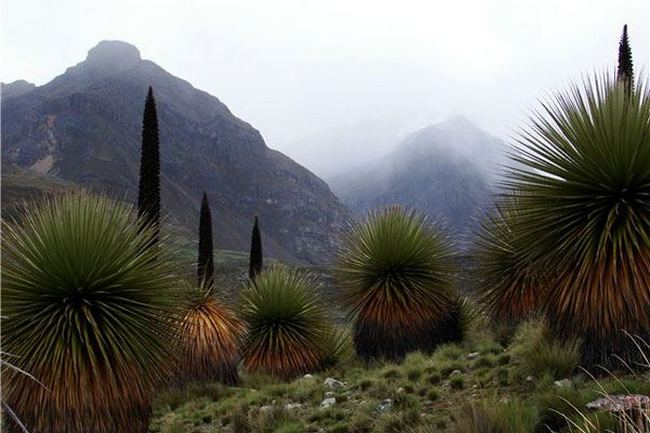
A distinctive feature of this plant, which is found in the Bolivian and Peruvian Alps, is the presence of a large inflorescence - its height can be twelve meters, and in diameter it can be up to 2.5 meters. As a part of the inflorescence, as a rule, you can count 10,000 simplest flowers. Upon reaching the age of 150 years, the puya blooms, and after flowering the plant dies.

Called the "silver apricot" plant happened 16000000 years ago, so it can reasonably be considered the oldest on the planet. It is a tree whose height can reach thirty meters. The life span of a ginkgo may be 2500 years. The leaves of the relic Chinese tree are used by the locals to create medicines, the effect of which is still very doubtful.
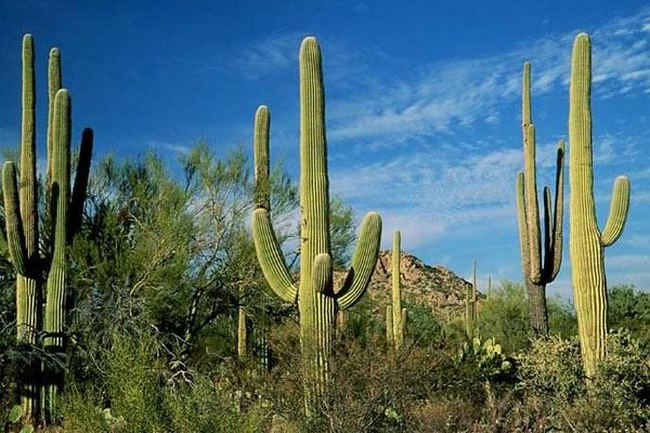
The plant is also called “the saguro cactus”, since it belongs to the cactus family. The place of its growth is California, Mexico, Arizona. The main feature of the cactus in its size is that it can grow up to 15 meters. The largest representatives of this plant species even have a weight of 10,000 kg. The carnegia flower has 3,500 stamens, which are so large in size that birds make nests on them.
This is the most amazing plant of the world growing in South America and is the largest water lily. In diameter it can be up to three meters. Not only a child, but also an adult weighing no more than 50 kg is quietly placed on a huge and durable sheet of Victoria's Amazonian. The plant at different times of day has different shades. White flowers above the water can be seen in the evening, and by morning they hide under water. They float again in the afternoon, representing a floating sheet of pink, purple or crimson color. The plant blooms a couple of days, after which it finally disappears under water.
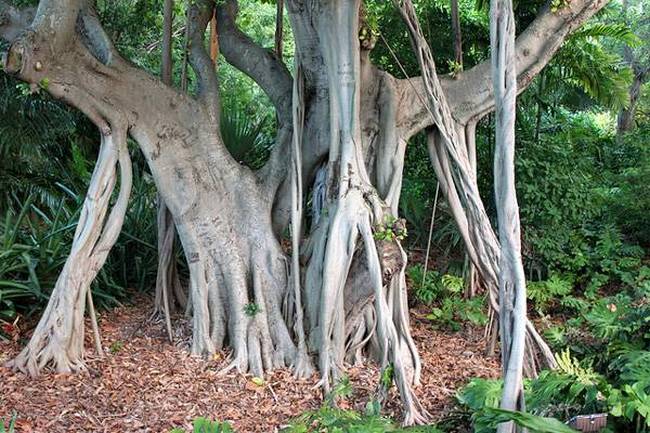
This plant, which is the tree with the most spreading crown, grows in Bangladesh, India and Sri Lanka. The main feature of it is the formation of powerful branches, from which down comes a lot of branches, seeking to take root and give new trunks. But they can dry out “on the road” before they reach the ground. A tree, growing at a rapid pace, is able to occupy whole hectares of land. The most famous Ficus is called the Great Banyan, which can be seen in the Indian Botanical Garden (in Haura) - there it occupies an area of 1.5 hectares.
How amazing our planet Earth with all its natural diversity! Just think - in everyday life we are surrounded by more than 320 thousand species of plants. But these are only those that are described by the science of botany, which every day reveals more and more new species. All this wealth, which gives the planet oxygen, is scattered around the globe. And in this article from all over the world are collected the most interesting and rare plants in the world.
This wonderful plant belongs to the family of Lyubka and is considered the rarest in the world. Now wild steppe orchids can be found only in five US states, as well as in the countries of the Midwest.
According to the Coalition of Disappearing Species, there are only 172 varieties of such an orchid in the world, and four of them consist of just a thousand specimens.
The western steppe orchid is a wetland plant, and its growing places are prairie potholes and ancient glacier indentations that left their traces about 20 thousand years ago.
The plant is threatened with extinction due to global warming, frequent fires, and the fact that it is simply trampled by livestock.
Rafflesia

The full name of this plant is Rafflesia Arnoldi, or Rafflesia arnoldii. This tropical plant is considered the largest flower in the world. In fact, the whole plant is a flower, as it does not have roots, stem and leaves in their usual sense. The sharp smell of decaying flesh emanates from rafflesia, which is why the plant is called a corpse-flower. But it's not just like that - the smell of rotting meat attracts flies, which bathe in a finger, and then carry it to another plant in order to make cross-pollination.
Interestingly, rafflesia often blooms along elephant paths, and the reason for this is the way the seeds spread.
The plant bears fruits with pollen on which elephants step on and carry pollen from the ball further on their feet.
Amorphophallus titanic

Amorphophallus, or Amorphophallus titanum, has the highest height among flowers and the second largest flower in the world after rafflesia. Like its giant sister, this plant exudes the foul smell of rotting flesh to attract flies to help pollinate flowers. Like rafflesia, amorphophallus was common in Indonesia, but people almost destroyed this species in its natural environment. Now this amazing plant is grown, as a rule, in greenhouse conditions in botanical gardens.

Dragon tree

Dragon tree, or Dracaena dragon ( Dracaena draco), got its name for the red juice that stands out from the plant, which in ancient times was considered dragon's blood. Legend has it that once upon a time bloodthirsty dragons eating elephants lived on earth. But once a big elephant crushed the most powerful dragon, and a dragon tree grew from the blood of a murdered mythical creature. Moreover, the leaves of this tree are so hard that brushes can be made of them, and people can fit in the hollow of a particularly old tree.
Interestingly, dracaena dragon does not form growth rings, so it is sometimes impossible to determine the age of a tree from a slice.
However, it is known that some trees of this species can live up to 7-9 thousand years.
In ancient times, "dragon juice" was used for medicinal purposes and for embalming, and in the Middle Ages was popular among alchemists.
The dragonberry is growing in tropical and subtropical zones of Africa, as well as on islands in southeast Asia. The tree can also be found in the Canary Islands, but because of the collection of red resin, it has become very rare.
African gidnor

Both the bright color and the putrid smell of decomposition coming from the plant serve to attract insects that help in pollination.
Moreover, the scavengers themselves often lay eggs inside the flower of the plant.
By the way, in the places where the fetus grows, hydnori is actively used in food, and its rhizome is used to treat diseases of the heart and blood vessels.
Selenitsereus krupnotsvetkovy
Selenicereus grandiflorus) - truly magnificent and incredible plant. The other name of this exotic plant of the cacti family is the Queen of the Night, and for a reason. The fact is that the flowers of this cactus bloom only once a year, and flowering lasts one night. But this is so beautiful and unique sight that botanical gardens arrange a special night entrance for visitors who want to see with their own eyes how these wonderful fragrant flowers bloom.
Selenitsereus lives in the West Indies, Mexico and the southeastern United States. Despite the fact that the process of growing this cactus is complicated (shoots reach several meters in length), experienced gardeners and lovers of the exotic sometimes grow selenisereus at home.
Pseudolithos) - Another unusual plant that looks very exotic at home. It looks more like a hilly stone covered with dense snake scales. Even its name means "fake stone". Inflorescences grow in groups on the surface of this egg-shaped trunk.
Over time, purple-brown flowers are formed in the pods, which burst when ripe. A bursting pod produces from 30 to 80 seeds, each of which has small villi-parachutes.
It is possible to find pseudolithos in natural habitat conditions in Somalia, on the territory of Yemen and Oman.

Predatory plant nepentes ( Nepenthes) looks like a green bush with multi-colored spotted jugs (also called a jug). But the attractive appearance of these water lilies is deceptive and designed to attract insects that the plant feeds on. Such an amazing plant lives on the territory of Madagascar, Seychelles, New Guinea, Australia and the island of Borneo. Unlike the predatory Venus flytrap, at home Nepentes is bred quite rarely - it is an exotic plant that requires meticulous care.
In the tropical forests of Asia, there is a plant of the genus Nonpents, capable of absorbing not only insects, but also frogs and small rodents.
And if home nepentes does not exceed 60 cm, then wild predatory nepentes from tropical forests can grow up to 20 m.
Velvichiya amazing

Velvichiya can do without water for up to 5 years, feeding on atmospheric moisture.
The largest known velvichiya has a height of 1, 4 m, and its age is about 1.5 thousand years.
Many plants in the modern world are endangered, which is to a large extent "favored" by human activity. It was not for nothing that the Soviet literary critic Cornelius Zelinsky said: "Human behavior in nature is also a mirror of his soul." Let us take care of the house in which we live in order to preserve all this amazing diversity of our planet.
Don't forget to get more amazing news and tips straight to your email!
Did you know that the height of the tallest trees exceeds 100 meters? Have you heard anything about plants that can "kill" and "eat" animals? In this article you will learn many amazing, interesting and even shocking from the life of plants.
1. Velvichiya amazing (Welwitschia mirabilis).
Photo source:
The age of this desert tree dwarf can reach 2000 years. From the short hemp-like stem of the plant, in both directions, two huge leaves go off, which, as they grow, are torn longitudinally into ribbons, and the tips wither. The age of these giant leaves is equal to the age of the tree. The leaves are constantly growing from the base, and the tips die off. In some cases, the length of the leaves can reach 8 meters and a width of 1.8 meters.
The genus Amorphophallus, as well as the Rafflesia genus, is famous for its “delicate aroma” of decaying flesh. The smell coming from the flower is terrible. Without a gas mask, few are capable of admiring amorphophallus. The flower of most members of this genus is huge in size (Especially in the species shown in the photo Amorphophallus titanum) and can reach a height of 2.5 meters with a diameter of 1.5 meters. In many eastern countries, the tubers of this plant are used in the preparation of various culinary dishes and medicines.
(Opuntia bigelovii)
Photo sources:
Opuntia Bigelow is probably one of the most amazing species of the Opuntia family of the Cactus family. The photo presented above was taken in California's Joshua – Tree National Park. In the photo, the entire desert landscape to the horizon is covered with amazing fluffy cacti, up to two meters high. In the rays of the setting sun, the landscape looks fantastic. The person here is given the impression that he, as part of a space expedition, landed on another planet covered with unknown life forms.
5. Carnegia giant (Carnegiea gigantea)
Photo sources:
Carnegia giant (Saguaro) is another amazing plant of the Cactus family. The most amazing feature of this cactus is its gigantic size. The height of individual plants is about 14 meters, and the diameter is more than 3 meters! In this case, the age of individual cacti reaches 150 years.
(Nepenthes)
Photo sources:
Most of the plants of this genus can, without exaggeration, be called "predators", which receive the necessary missing nutrients, "digesting" the caught insects. The plant has modified leaves that resemble jugs in form. The inner surface of the pitcher is lined with nectar-excreting cells, which serve to attract insects, as well as "hair cells" that make the release of an insect "in the net" impossible. The surface of the “neck” of the jug is very slippery, so there is almost no chance that an insect walking along the neck of the insect slides down. An insect falls into the water (for some species, the jug may contain up to 2 liters of water) and sinks. Further, enzymes are produced that completely "digest" the insect. Sometimes not only insects are trapped, but even mice , rats, birds.
The Venus flytrap is an even more amazing “killer plant” that takes more action to kill its prey. Modified leaves, "jaws" of this plant encroach on the life of not only insects, but also on life.
You can “enjoy” the rest of Venus's flytrap's amazing “fighting feats” in the video.
(Ficus benghalensis)
Photo source:
At first glance it may seem that the photo above shows a forest. In fact, this is one single tree. The ficus of Bengal forms powerful branches for the support of which shoots grow, which are rooted down to the ground and take root, forming powerful columns-trunks.
9. Seasoning evergreen (Sequoia sempervirens)
Photo source:
Evergreen Sequoia is the tallest tree on our planet. Our temperate forests are grass compared to the forest of these powerful giants. The height of many trees exceeds 110 meters, and the age is more than 3500 years! Previously, in the trunks of redwoods hollowed out houses and even cut through tunnels through which the roads passed. In windy weather, many visitors to the forest of giants feel uncomfortable with the noisy “rattle” and swaying of the mighty redwood trunks. It grows in California.
(Puya raimondii)
Photo source:
The Puia Raymond family of Bromeliads that grows in the Bolivian and Peruvian Andes has the largest inflorescence of 2.5 meters in diameter and about 12 meters in height, consisting of approximately 10,000 simple flowers. It is a pity that this amazing plant blooms only when it reaches 150 years of age, and then dies.
When using please refer to
(Visited 34 101 times, 23 visits today)
